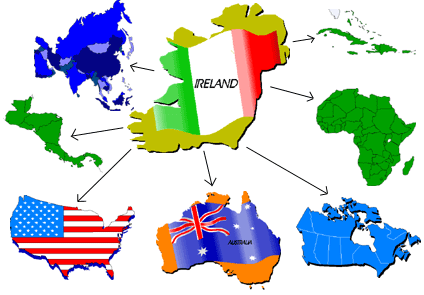
Over the centuries millions of Irish have immigrated to Europe, other countries in the British Isles, the continent of Africa, North and South America, the Indies, Australia, New Zealand, the Caribbean Islands, and elsewhere throughout the world. The reasons for emigrating were as varied as the emigrants. Some chose to leave Ireland voluntarily. Others were forced to leave for political or economic reasons. One brother may have gone to one country, another brother to another country, and so forth.
WEBSITE:To understand more about the Irish diaspora, see Sources on Irish Migration: Select Bibliography at the National University of Ireland, Cork Website http://migration.ucc.ie/bibliography.htm. Many more studies have been published since this extensive list was compiled in 1996. Some of the lessons that will need to be learned are listed on the next page, but we need more foundation skills before diving into these lessons. We need to study the ethnic group itself. Much of this information can come from learning about your ancestor's town, state, and county in America. As you are learning about the geography and jurisdictions of your ancestor, you might pick up clues on their ethnic customs. See what was learned about the Irish in general in the paragraphs below.
Studies show that the Irish seldom went abroad alone. Family bonds, either by blood or by association (neighbors and friends), extended across the ocean. Communities within cities or the rural communities to which the Irish went and eventually settled were usually inhabited by kin or friends. For this reason it is imperative that all members of the family be researched as well as the Irish with whom an ancestor lived, worked, and worshiped. Thus, whether you have Irish or Spanish ancestry, Portuguese or German ancestry, or any other, you will need to know what motives attracted settlers to the areas they settled in their new home. What religion or peculiar local customs did your ancestor have as well as the people in the town, county, city, or area where he or she settled? These are questions you will be asked to answer in this week's assignment.
In addition to the normal sources we have mentioned in previous chapters in our reading or these online lessons such as church and vital records, census returns, passenger lists, naturalization records, obituaries, tombstone inscriptions, and published sources, there are other less obvious resources (often unique to one ethnic group or another) that may yield important clues. It is important to search any and all available records in an effort to document your family.
Below are a few more obscure record sources that contain genealogical information including dates and places of birth for Irish immigrants. This list of sources is far from complete, but it is helpful. It is hoped that the examples used will stimulate you to think of some types of records that could contain useful information on your own families.
BANK RECORDS
Banks kept records of their customers. While all banks recorded the name, and address of each customer and monetary transactions, personal details may also be listed. Of note are the records of the Emigrant Savings Bank in New York City. These records are being transcribed by volunteers and information is entered on the �Genealogy Exchange and Surname Registry� web site www.genexchange.org which is interesting to study.
In addition to the name and address of the account holder, other information listed includes the place of birth; occupation; name of spouse; name of parents including the mother�s maiden name; names of other relatives such as cousins, nieces, uncles, etc.; the name of the ship and the date of arrival.
My own immigrant grandfather was from Finland and it was a bank statement on the National Bank of Finland that finally solved the mystery of his parish of origin. I know that this works if you are fortunate enough to find such a record.
|